Get the drop on bass
Drop-shot tactics offer diverse strategies for bass anglers
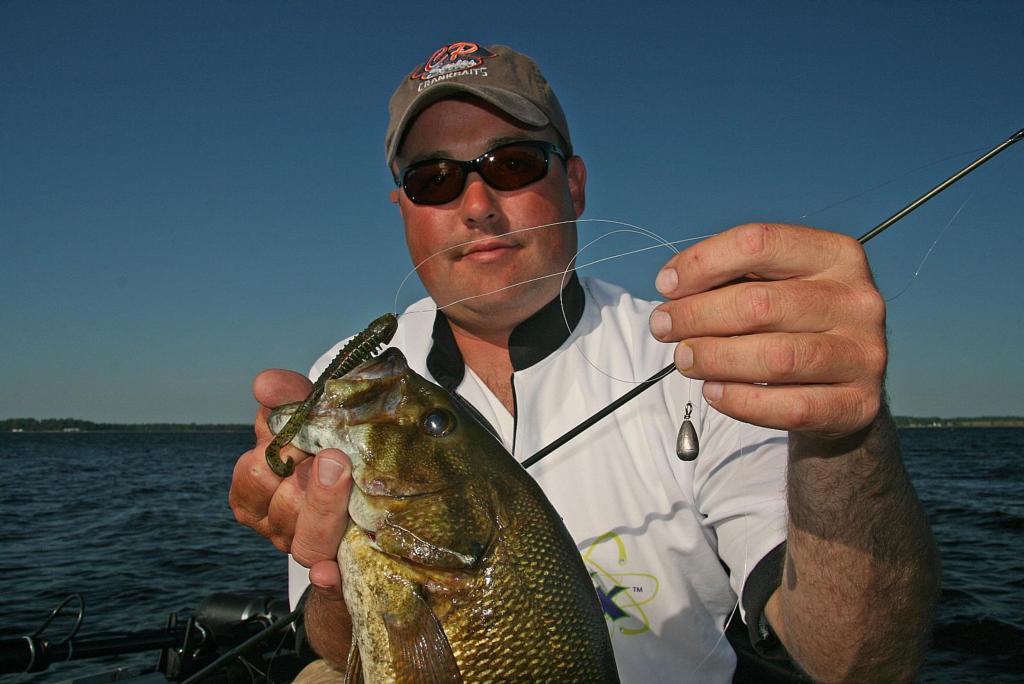
Not so long ago, the fishing world thought that weights always belonged above baits. Over the past decade or so, the drop-shot tactics introduced by Japanese anglers have turned that thinking upside down (no pun intended). Today, this finesse rig’s progressive design has been adapted, modified and employed in a variety of scenarios with widespread success.
With its weight dangling from the tag end of a hook, standing perpendicular to the main line, a drop-shot is easy to tie, easy to cast and unquestionably effective when bass play hard to get. Requiring little to no action, it’s about as user-friendly as you’ll get, but don’t let the simplicity fool you – the drop-shot has earned its place in the arsenals of serious anglers.
Whether it’s California’s Clear Lake, TVA reservoirs, the Great Lakes or mountain gems like Champlain, FLW competitors find drop-shot scenarios throughout their travels. This finesse tactic played a major role in the 2010 Forrest Wood Cup, as most of the field worked the deep brush piles scattered throughout Georgia’s Lake Lanier. Like most rigs, the drop-shot’s potential is limited only by one’s creativity, but here are a handful of common scenarios from which anglers can expand.
Play deep: From Lanier’s abundant brush piles to rocks, stumps or any other submerged fish magnet, sonar is the great facilitator of offshore drop-shotting. Seasoned pros like Pennsylvania’s 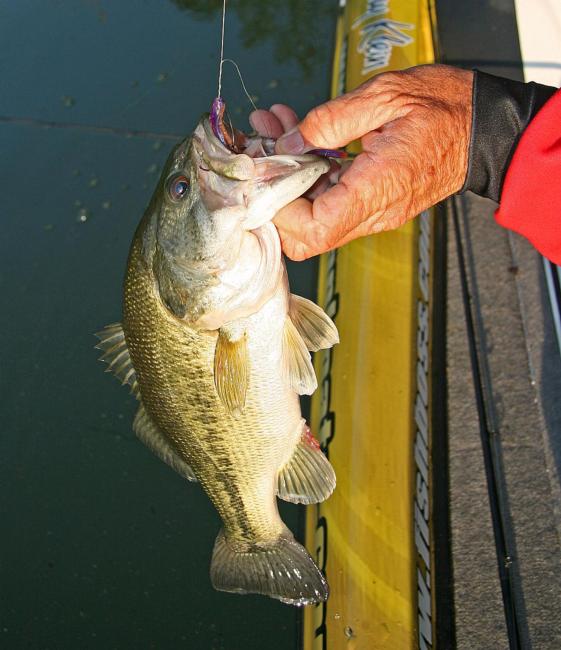
Jason Ober call it “video gaming” – the practice of hovering over structure and watching the fish react to your drop-shot presentations. On a good day, you drop down and hold the bait on target until one of the fish marks starts wiggling – then you reel.
Ober, who won the EverStart Series event on Lake Champlain in 2008, drops on deep structure with a ¼- to 1/2-ounce weight and a Berkley Gulp Leech or Minnow. Worms also work well here – especially the ultralimber styles like a Roboworm or a Berkley Powerbait Hand Pour Finesse Worm.
Bed fishing: Catching a big female is mostly a case of irritating her with persistent intrusion. No other rig can hold its position in the fish’s face without actually disrupting the bed like a drop-shot. Preferring a 3-inch Roboworm or a Berkley Gulp Minnow, Florida pro Matt Greenblatt said he’ll typically use a 3/8-ounce weight, but he may go as heavy as ¾-ounce in windy conditions.
Suspended fish: When fish hold over standing timber, in front of deep docks or along bridge pillars, Ober uses his drop-shot to work through the school and trigger a bite by mimicking a dying shad. Often using this presentation for schooling bass, Ober rigs a light 1/16- or 1/8-ounce weight and sends a Berkley Gulp Minnow or a Yamamoto Shad Shape Worm into the fish.
“I cast out, kick the reel in gear and let the bait pendulum into the suspended school,” he said. “I’ll never let the bait hit bottom.”
Power play: The drop-shot may have been conceived as a finesse tactic, but don’t pigeon-hole this rig. As Yamaha pro Stetson Blaylock notes, upsizing the rig’s components affords yet another presentation option – this one called “power-shotting.”
“When people think of drop-shotting, they think of superlight line, a little tiny hook, a small weight and vertical fishing,” Blaylock said. “Well, I fish a drop-shot a lot on a 7 1/2-foot medium-heavy rod with 15- to 20-pound line and a 7-inch worm and a 3/8-ounce weight around heavy cover. It’s power-drop-shotting.”
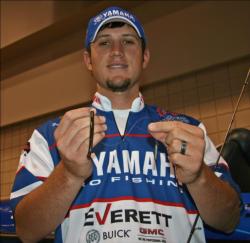 Blaylock said he’ll often cast, flip or pitch his hefty drop-shot as he would a jig or Texas-rigged plastics around lay-downs and other structure. Because even heavy drop-shots are more subtle than a traditional flipping or pitching bait, Blaylock finds that hooked fish are usually less agitated than those stuck by bulky baits. That means they’ll come through the cover easier with less chance of tangling.
Blaylock said he’ll often cast, flip or pitch his hefty drop-shot as he would a jig or Texas-rigged plastics around lay-downs and other structure. Because even heavy drop-shots are more subtle than a traditional flipping or pitching bait, Blaylock finds that hooked fish are usually less agitated than those stuck by bulky baits. That means they’ll come through the cover easier with less chance of tangling.
Under surveillance
For those who would master the drop-shot, investing in quality sonar will yield a better understanding of what the fish are doing and how to approach them. As National Guard pro Brent Ehrler saw in his second-place FWC finish, bass position and disposition will drastically change from one day to the next. That’s when high-end electronics like Ehrler’s Lowrance HDS-10 with StructureScan really shine. Not only does StructureScan provide incredibly detailed images of bottom features that attract fish, but it also provides a greater vision of the fish’s movement.
“Not only could you see them down there, but you can see how they were reacting to the (drop-shot),” he said of his Cup fishing experience. “On day one they were grouped up so (anglers) had an easy time catching them, but on day two they were more spread out. When they were grouped up, they were more likely to bite because they were competing, but when they were singles, they weren’t as likely to bite.”
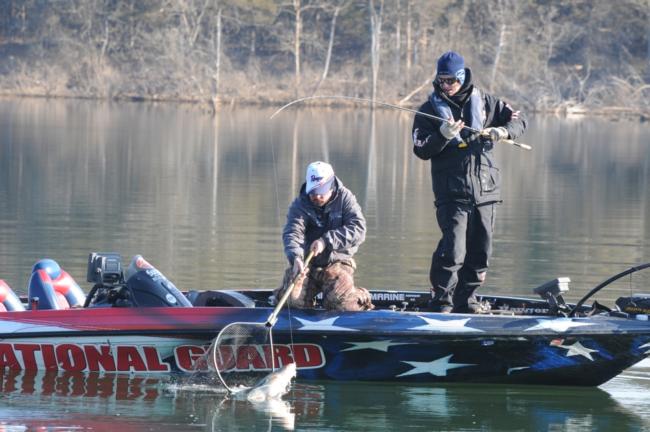 Ehrler’s strategy? Watch closely to see specifically where the fish were holding and what angles were the chain-yankers.
Ehrler’s strategy? Watch closely to see specifically where the fish were holding and what angles were the chain-yankers.
Ehrler offers details: “I just made different presentations to try and irritate them. I just tried to keep it in front of them as long as possible. If the fish come into the screen and leave, you know they’re not down there (on the targeted structure), but if they’re staying on the screen, you want to keep your bait down there as long as possible.
“If the fish are there, you may have to try different things. Maybe you just let the bait sit there; maybe you try winding really fast and then letting it drop fast. They’ll key on one thing and that will make them react.”
Tackle talk
With the exception of the bulked-up power versions, drop-shots are best fished on spinning gear.
Greenblatt, who drop-shots with an e21 Carrot Stix 731 medium-heavy spinning rod and a Pflueger 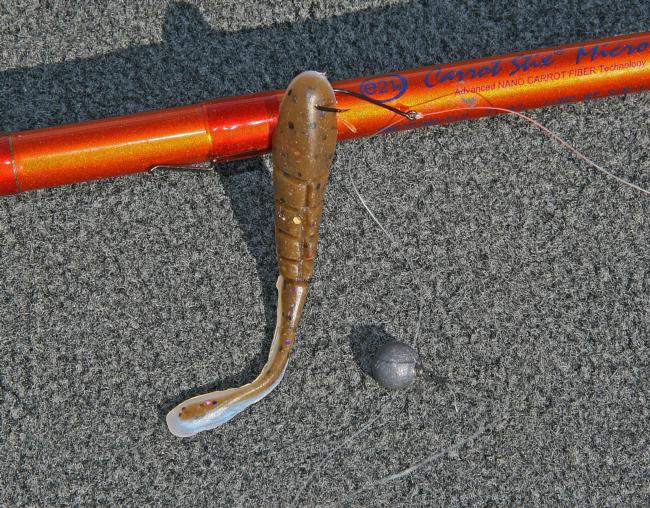 President reel, explains: “A drop-shot is best fished on spinning gear due to the (light line) needed to fish the light lures. We use 4- to 8-pound-test for most drop-shotting. There is also no real hookset while fishing a drop-shot. The set is no more than a lift and reel. A spinning outfit gives you more control to make the exact cast with a light line/lure combo.”
President reel, explains: “A drop-shot is best fished on spinning gear due to the (light line) needed to fish the light lures. We use 4- to 8-pound-test for most drop-shotting. There is also no real hookset while fishing a drop-shot. The set is no more than a lift and reel. A spinning outfit gives you more control to make the exact cast with a light line/lure combo.”
Leader length: Opinions vary on this one, but most agree that tall structure merits longer leaders – sometimes 4 feet or more. You may want to probe the sides and lower extremes of a brush pile or standing timber, but when fish hold above something standing a yard stick or more off the bottom, they’re usually looking up more than down, so baits must hold in the strike zone.
For everyday drop-shotting – as in no tall stuff – Ober has a common-sense formula for tying his leaders: “I want my leader long enough so I can hang my hook in the rod’s first eyelet, pull my weight level with the reel seat and (secure it) with a rubber band that I place around the reel seat.”
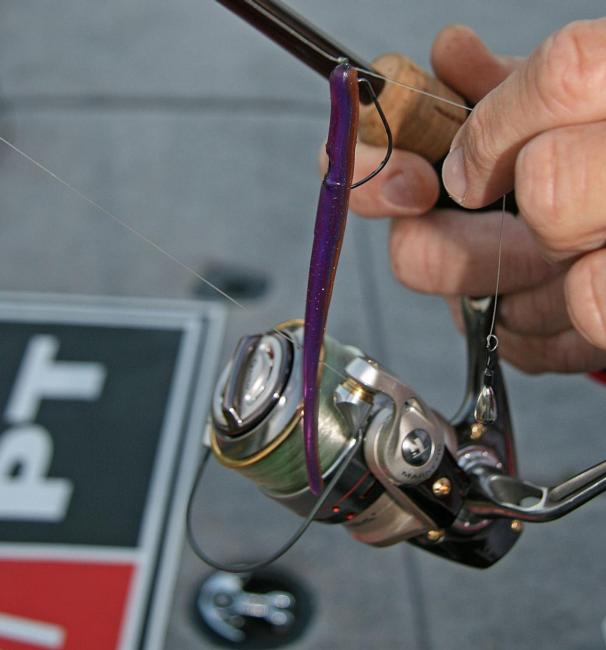 Weighting game: Drop-shot weights vary not only in size, but also in shape, based on the scenario. Generally, cylinder (“stick”) weights are best when rocks, wood or thick grass threaten snagging. Round weights easily slide through tules and other sparse structure, while bell (“teardrop”) weights put more surface mass in contact with the bottom for greater sensitivity in detecting gravel or other key elements.
Weighting game: Drop-shot weights vary not only in size, but also in shape, based on the scenario. Generally, cylinder (“stick”) weights are best when rocks, wood or thick grass threaten snagging. Round weights easily slide through tules and other sparse structure, while bell (“teardrop”) weights put more surface mass in contact with the bottom for greater sensitivity in detecting gravel or other key elements.
Vary the menu: Don’t hesitate to experiment with various bait shapes and sizes. For example, 3- to 4-inch worms are common, but a 6-incher may be what you need to trigger the strikes. Conversely, if a good bite wanes try biting an inch or so off the worm that has been working, and the smaller profile may do the trick. For greater bait profile and motion, try a tube or a small creature bait like the Zoom Tiny Brush Hog.
Hooking styles: When the fish are biting aggressively, Ober hooks his baits through the head to 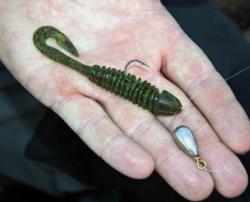 avoid deep hooking. For light bites, Texas rigging the bait with a small wide-gap worm hook puts the point further into the body and, hopefully, closer to a fish’s mouth. (This weedless style is helpful around wood or thick vegetation.) Don’t forget wacky rigging. Stick your hook through the bait’s center or under an O-ring for enticing action.
avoid deep hooking. For light bites, Texas rigging the bait with a small wide-gap worm hook puts the point further into the body and, hopefully, closer to a fish’s mouth. (This weedless style is helpful around wood or thick vegetation.) Don’t forget wacky rigging. Stick your hook through the bait’s center or under an O-ring for enticing action.
Remember, head hooking and wacky hooking leaves the point exposed and thereby easily snares anyone that bites. With a weedless arrangement, you’ll need to set the hook more vigorously to pull the point through the bait and into your fish.